Respiratory Failure in Patients with Intracerebral Hemorrhage and Intraventricular Hemorrhage Extension: A Retrospective Study
- PMID: 40805909
- PMCID: PMC12345717
- DOI: 10.3390/healthcare13151876
Respiratory Failure in Patients with Intracerebral Hemorrhage and Intraventricular Hemorrhage Extension: A Retrospective Study
Abstract
Background/Objectives: This study aimed to identify the risk factors for respiratory failure in patients with intracerebral hemorrhage (ICH) accompanied by intraventricular hemorrhage (IVH) extension. Methods: We retrospectively included 208 patients with ICH accompanied by IVH extension. Respiratory failure was defined as carbon dioxide levels > 45 mmHg with a pH < 7.35 in arterial blood gas analysis (ABGA) or the application of a ventilator due to respiratory dysfunction. We measured the severity of IVH extension using the Graeb scale, and ICH volume was assessed for each patient. Results: Of the 208 included patients, 83 had respiratory failure. There were no significant differences in age, sex ratio, or Graeb scale score between patients with and without respiratory failure (p > 0.05). However, ICH volume was significantly larger in patients with respiratory failure (42.0 ± 42.5 mL) than in those without (26.4 ± 25.7 mL) (p = 0.003). In the receiver operating characteristic (ROC) curve analysis, the area under the ROC curve for ICH volume predicting respiratory failure was 0.612. The optimal threshold for detecting respiration failure in patients with ICH and IVH dilatation, based on the Youden index, was >63.2 mL, with a sensitivity of 30.12% and a specificity of 89.60%. Approximately 40% of patients experienced respiratory failure following ICH accompanied by IVH extension. Conclusions: A large ICH volume was associated with the occurrence of respiratory failure. Therefore, caution is required in patients with an ICH volume > 63.2 mL.
Keywords: intracerebral hemorrhage; intraventricular hemorrhage; prediction; respiratory failure; stroke.
Conflict of interest statement
The authors declare no conflicts of interest.
Figures
Similar articles
-
Extracorporeal carbon dioxide removal for the treatment of acute hypoxaemic respiratory failure: the REST RCT.Health Technol Assess. 2025 Jul;29(33):1-16. doi: 10.3310/GJDM0320. Health Technol Assess. 2025 Jul;29(33):1-16. doi: 10.3310/GJDM0320. PMID: 40758387 Clinical Trial.
-
Prescription of Controlled Substances: Benefits and Risks.2025 Jul 6. In: StatPearls [Internet]. Treasure Island (FL): StatPearls Publishing; 2025 Jan–. 2025 Jul 6. In: StatPearls [Internet]. Treasure Island (FL): StatPearls Publishing; 2025 Jan–. PMID: 30726003 Free Books & Documents.
-
Are Current Survival Prediction Tools Useful When Treating Subsequent Skeletal-related Events From Bone Metastases?Clin Orthop Relat Res. 2024 Sep 1;482(9):1710-1721. doi: 10.1097/CORR.0000000000003030. Epub 2024 Mar 22. Clin Orthop Relat Res. 2024. PMID: 38517402
-
Haemostatic therapies for stroke due to acute, spontaneous intracerebral haemorrhage.Cochrane Database Syst Rev. 2023 Oct 23;10(10):CD005951. doi: 10.1002/14651858.CD005951.pub5. Cochrane Database Syst Rev. 2023. PMID: 37870112 Free PMC article.
-
Accuracy of the ABC/2 Score for Intracerebral Hemorrhage: Systematic Review and Analysis of MISTIE, CLEAR-IVH, and CLEAR III.Stroke. 2015 Sep;46(9):2470-6. doi: 10.1161/STROKEAHA.114.007343. Epub 2015 Aug 4. Stroke. 2015. PMID: 26243227 Free PMC article.
References
-
- Zhu W., Gao Y., Wan J., Lan X., Han X., Zhu S., Zang W., Chen X., Ziai W., Hanley D.F., et al. Changes in motor function, cognition, and emotion-related behavior after right hemispheric intracerebral hemorrhage in various brain regions of mouse. Brain Behav. Immun. 2018;69:568–581. doi: 10.1016/j.bbi.2018.02.004. - DOI - PMC - PubMed
LinkOut - more resources
Full Text Sources


